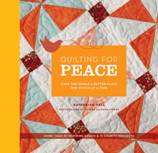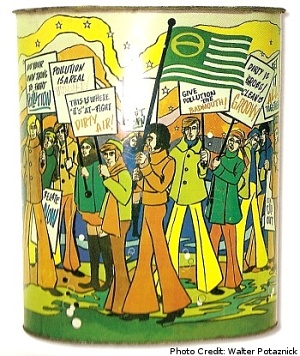 Quilting for Peace is the latest in craft books by Katherine Bell. In the pages you’ll find stories and inspiration of organizations as well as people using sewing and quilting to help make the world a better place.
Quilting for Peace is the latest in craft books by Katherine Bell. In the pages you’ll find stories and inspiration of organizations as well as people using sewing and quilting to help make the world a better place.
The book covers giving to deserving charities as well as using quilts as an activist tool. There are patterns and projects to replicate those the organizations make as well as where to donate your creation if you so choose.
From veterans to kids, Quilting for Peace covers a wide range of issues in which sewing has brought people together for a cause. We asked Katherine to stop by talk a bit about her book and quilting from an environmental perspective.
The following is written by Katherine:
Quilts can change people’s minds and alter the course of history. That was the idea behind 19th century quilts promoting prohibition and abolition, the 1,293,300-square-foot, 54-ton AIDS Memorial Quilt, and The Ribbon, a project that wrapped the Pentagon and Hiroshima’s Atomic Bomb Dome in miles of quilts to protest the nuclear arms race. Now a new generation is using patchwork to call attention to an existential threat – this time it’s climate change. Here are three ways you can join them.
First, do no harm
The average American throws away more than 60 pounds of fabric a year (that’s the average American person, not the average American quilter), and discarded textiles take up four percent of our landfills. So use recycled fabric in your craft projects whenever you can. Cut up out-of-style and too-small clothes for patchwork, and ask your friends to save their used clothing for you too. Never throw away scraps of quilting fabric. You can make gorgeous string quilts (see the community quilting chapter of Quilting for Peace for a pattern) and Chinese Coin quilts out of narrow little scraps of fabric sewn to a muslin foundation. The members of Heartstrings, an online quilting group, make string quilts for an assortment of charities. You can send them a single string block (with a red center), and they’ll add it to one of their quilts in progress.
A quarter of the insecticides used globally each year are used on cotton crops. When you buy fabric, support companies that make organic cotton fabric and batting as often as you can afford to. Michael Miller makes great basics, and Mountain Mist sells eco-friendly batting.
Become a guerilla bagger
Claire Morsman, an environmental activist in London, learned to make shopping bags out of recycled fabric so she’d never have to use plastic. Then she started morsbags, an international network of crafters who get together and sew shopping bags, then give them to unsuspecting shoppers in front of supermarkets. She estimates they’ve made over 54,000 bags so far. The bag she designed — which she generously let me put in the book — is extra-strong to handle heavy groceries and it takes about half an hour to make. If you carry around handmade bags made out of interesting fabric, you’ll end up talking to your admirers about the environment on a regular basis.
Inspire the kids you know to become environmental activists
A number of large-scale quilt projects inspired by the AIDS Memorial Quilt aim to get kids thinking about global warming and to use their art to raise awareness among adults as well. Kids can design and sew and/or paint a design on a square of recycled fabric to show how they feel about global warming for Blanket the Globe, a quilt project started by Casey Ehrlich, a high-school student in Massachusetts. Another project, the Climate Quilt Campaign, is putting together a massive quilt made by children from all over the world to display at the UN Climate Summit in Copenhagen in December.
Author Katherine Bell contributed to this post








Pingback: Quilting for Climate Change Awareness - Zidee.com
Pingback: Quilting for Climate Change Awareness